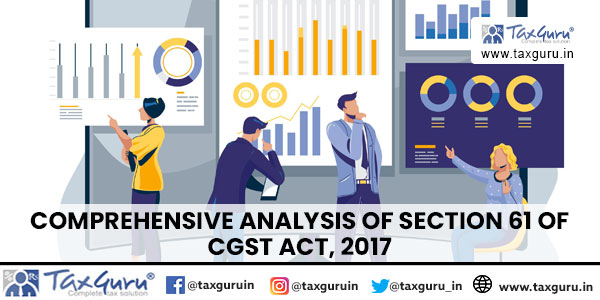‘Assessment’ is one of the word in taxation field which worries the most to the registered tax payers as well as professionals. Under Goods & Service Tax (GST), assessment is defined under Section 2(11) and today we will analysis one of such assessments under GST Law i.e. Section 61 which comes is a assessment of returns initiated by the Officer.
This article tries to provides a detailed exploration of Section 61, including its text, key provisions, and practical implications for taxpayers.
Scope of assessment in GST is very limited and different as compare to other fiscal laws like Income tax and applicable to specified suppliers and even such supplier need not to be assessed every year

Let us first look at the Original Text of the Section:
Section 61. Scrutiny of returns.-
“(1) The proper officer may scrutinize the return and related particulars furnished by the registered person to verify the correctness of the return and inform him of the discrepancies noticed, if any, in such manner as may be prescribed and seek his explanation thereto.
(2) In case the explanation is found acceptable, the registered person shall be informed accordingly and no further action shall be taken in this regard.
(3) In case no satisfactory explanation is furnished within a period of thirty days of being informed by the proper officer or such further period as may be permitted by him or where the registered person, after accepting the discrepancies, fails to take the corrective measure in his return for the month in which the discrepancy is accepted, the proper officer may initiate appropriate action including those under section 65 or section 66 or section 67, or proceed to determine the tax and other dues under section 73 or section 74 1[or section 74A].”
Important Points of Section 61 and Their Explanation
1. Authority for Scrutiny Section 61 give the power to the proper officer to scrutinize returns filed by registered taxpayers. This process involves verifying the correctness of the information provided, including taxable amounts, input tax credit (ITC), and tax payments.
- Objective: The primary goal is to identify errors, omissions, or mismatches in returns to prevent revenue leakage.
- Scope: The scrutiny is focused on correctness of returns filed and is limited to mistake apparent from returns.
2. Communication of Discrepancies Upon identifying discrepancies, the proper officer is required to notify the taxpayer in the prescribed manner and seek an explanation.
- Communication Method: Discrepancies are typically communicated through the GST portal, with registered dealer responding electronically. GST ASMT-10 will be served to the dealer with the discrepancies.
- Examples of Discrepancies: Common issues include mismatches between GSTR-3B and GSTR-1, discrepancies between claimed ITC and GSTR-2B, or inconsistencies in tax payments.
3. Acceptable Explanation If the taxpayer provides an acceptable explanation, the matter is resolved, and no further action is taken.
- Implication for Taxpayers: Registered dealer must respond using Form GST ASMT-11, providing explanations and supporting documentation within 30 days from date of service of notice.
If discrepancies are resolved by providing satisfactory explanations and providing supporting documents then the proper officer will issue Form GST ASMT-12 to close the matter.
- Example: If a taxpayer explains that an ITC mismatch is due to timing differences in supplier reporting, the officer may close the matter.
4. Unsatisfactory Response or Inaction If the taxpayer does not provide a satisfactory explanation within 30 days (or an extended period) or fails to correct the discrepancies after acknowledging them, further actions may be initiated.
These actions may include following :
| Section | Type of Action |
| 65 | Audit by tax authorities |
| 66 | Special Audit conducted by CA or CMA |
| 67 | Power of Inspection, search and seizure |
| 73 | Determination of tax not paid or short paid or erroneously refunded or input tax credit wrongly availed or utilised for any reason other than fraud or any willful-misstatement or suppression of facts |
| 74 | Determination of tax not paid or short paid or erroneously refunded or input tax credit wrongly availed or utilised by reason of fraud or any willful- misstatement or suppression of facts |
Note on Demand under Section 61
> It is important to note that no demand for tax can be raised directly under Section 61 of the CGST Act, 2017. The provision only deals with the scrutiny of returns and identification of discrepancies. If a demand for tax or penalties is to be raised, it requires invoking the provisions of Section 65 (Audit), Section 66 (Special Audit), Section 67 (Inspection, Search, and Seizure), or Section 73/74 (Tax Determination and Recovery of Dues). These sections outline the necessary procedures for the determination and collection of taxes, including the issuance of demand notices.
> Further would also to like to draw your attention that Sec. 61(3) requires the tax-payer to take corrective measure in his return for the month in which discrepancy is accepted but on the other hand Sec. 39(9) restricts rectification of omission or incorrect particulars discovered as a result of scrutiny, audit, inspection or enforcement activity by the tax authorities. Therefore, by virtue of Section 39(9), such corrective action as provided in Section 61(3) is debarred.
> Therefore, in cases where taxpayer admits the mistake and in such scenario every proceeding-initiated u/s 61 would lead to proceedings u/s 65/66/67 or determination under Section 73/74.
Pro-active Actions to be prepared for Section 61 Proceedings:
> Proactive Checks: Have a regular check of the data maintained in the accounting software with the GST returns filed, If any discrepancy prepare a reconciliation at the immediate moment and if there is any ITC Reversal or any amount is payable then such effects of variance should be given in subsequent return or pay via DRC-03, as the case may be
> Timely Responses: Always be prompt to reply any notices under GST Act with supporting documents and explanation. As it shows the Bonafide intention of the dealer and will have good impression on the Officer as being compliant dealer
> Use of Technology: Use of GST Software for reconciliation always saves time and efforts compared to manual intervention but data prepared which is used by software for reconciliation or discrepancy should be verified accurately to avoid any false reports of reconciliation.
Comparison with Related Provisions
> Section 65 vs. Section 61: Section 61 focuses on the scrutiny of returns, while Section 65 pertains to comprehensive audits, which include on-site verification of records.
> Section 74 vs. Section 61: Section 74 addresses tax determination in cases of fraud or wilful misstatement, whereas Section 61 is primarily concerned with identifying and addressing discrepancies in tax filings.
Conclusion
Section 61 of the CGST Act, 2017, underscores the importance of maintaining accuracy and transparency in GST compliance. By granting the proper officer the authority to scrutinize returns and seek explanations for discrepancies, it aims to uphold the integrity of the tax system while offering registered dealeran opportunity to resolve issues without immediate punitive action. Businesses must prioritize accurate reporting and timely reconciliation of their returns to navigate the scrutiny process effectively and mitigate the risk of further legal complications.
*****
Disclaimer: > We request readers to seek professional advice before arriving at any decision/conclusion after reading. We are not responsible for any loss arising to anyone after referring and relying on this article. Above views are based on our understanding of the provisions. > Author can be reached at office.bhavikco@gmail.com





